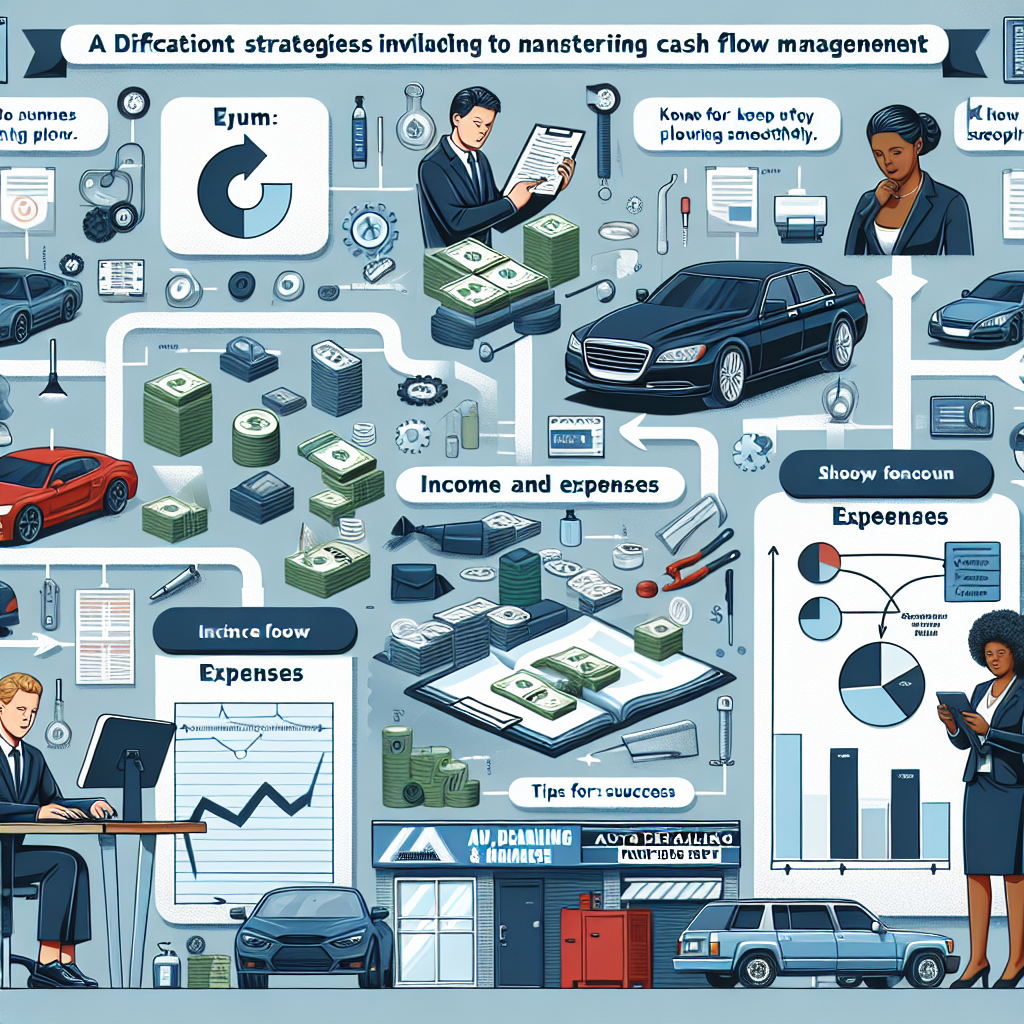Hey there, fellow auto detailing enthusiasts! Managing cash flow is not just a business skill; it’s an art. I’ve been in this industry long enough to know that cash flow is the lifeblood of any auto detailing business. Whether you’re just starting out or you’re a seasoned pro, these strategies will help you keep your business thriving. Let’s dive right in!
Understanding Cash Flow Fundamentals
The Importance of Cash Flow
First off, cash flow refers to the money coming in and going out of your business. Sounds simple, right? Well, it’s essential to understand that positive cash flow means your business is healthy. From my experience, when you have more money flowing in than out, you can pay your bills, reinvest, and grow!
I recall a time when I had overlooked the importance of managing cash flow, thinking, “I’ll make more money next month.” Spoiler alert: that doesn’t always pan out. Those unexpected expenses, like repairs or marketing pushes, can throw you off balance. That’s why knowing how to forecast your cash flow is crucial.
Ultimately, acknowledging your cash flow can help you make informed decisions. It’s not just about profits; it’s about cash going in. You can run a profitable business on paper but still struggle if you don’t manage your cash flow effectively.
Components of Cash Flow
Now, let’s break it down a bit. Cash flow consists of three main components: operating, investing, and financing activities. Operating activities are what you typically think of: income from services rendered and expenses related to day-to-day operations. My first year in business, I spend way too much time focusing on investments and financing, neglecting the operating part! While they’re crucial, they shouldn’t overshadow the basics.
Investing activities include cash inflow and outflow related to the purchase or sale of assets. For example, buying new equipment to enhance your services can eat up your cash flow but can pay off with increased business. It’s all about finding that balance. Financing activities deal with cash connected to loans, credit lines, or equity investments, which can help your business grow but also bring in extra responsibilities.
In summary, understand where your cash is coming from and where it’s going, and you’ll be well on your way to mastering cash flow. Keeping these elements in check can save you from nasty surprises down the line.
Cash Flow Forecasting
Forecasting cash flow for your auto detailing businees is an invaluable skill I learned the hard way. I’ve often found myself underestimating expenses or overestimating profits, leading to sleepless nights! To get better at it, I suggest creating a cash flow projection – a detailed overview of expected income and expenses.
This can include everything from seasonal changes in service demand to regular bills like rent, payroll, or supplies. I’ve found it useful to look back at previous months to get a realistic idea of what to expect. This practice helped me identify patterns and prepare for slow seasons. I can confidently say, stay ahead of the game.
Also, don’t forget to keep your projections flexible. If unforeseen expenses come up, you’ll be ready! Keeping tabs on your cash flow will give you a sense of control because you’ll know when to pull back on spending and when to invest.
Establishing a Cash Reserve
Why You Need a Cash Reserve
Let me tell you about cash reserves! Think of it as a safety net for your business. I’ve learned that when an unexpected expense pops up (because they always do), having a cash reserve can save the day. It’s almost like having my personal superhero ready to swoop in when things get rough.
A cash reserve acts as your buffer. It allows you to manage those months when business dips for no reason or when you have surprise expenses, like equipment repairs. I recommend having enough to cover three to six months of operating expenses. It may seem daunting, but having that cushion can relieve stress and allow you to focus on growing your business.
As I started to build my cash reserve, I realized I could take calculated risks. Leaping into new marketing strategies or expanding services became easier. A cash reserve helps you feel less like you’re walking a tightrope and more like you’ve got a safety harness!
How to Build Your Cash Reserve
Building a cash reserve doesn’t happen overnight. I started by setting aside a small percentage of my monthly income. I know it’s tough — we’re often tempted to reinvest every cent. But trust me, just a small percentage goes a long way. I recommend treating your cash reserve like an expense: it’s non-negotiable.
I also encourage experimenting with ways to cut unnecessary expenses. For example, can you negotiate supplier prices? Or maybe ditch a subscription you never use? Every little saving adds up. Over time, you’ll build a solid reserve without drastically impacting your operations.
Lastly, automation can be your best friend. Setting up automatic transfers to a reserve account each month helps establish a routine. You get used to seeing less money in your spending account, but your reserve is steadily growing. Just watch that safety net get bigger!
When to Use Your Cash Reserve
Knowing when to dip into your cash reserve can be tricky. It’s tempting to use it for expenses that aren’t urgent. From personal experience, I recommend saving the reserve for real emergencies — like an unexpected bill or a trade show opportunity that could boost your business.
For instance, last year, I had a sudden surge in demand but no resources to meet it. I used a portion of my reserve to hire temporary help. It turned out to be an excellent investment, as I was able to capitalize on that surge. Trust me; you want to invest wisely when you do use it!
Make it a point to regularly review your financial status. While building a reserve is wise, there may come a time when reinvesting it into your business yields better returns than letting it sit. Balance is key; there’s a time for saving and a time for investing!
Expanding Your Revenue Streams
Identifying Opportunities
Okay, let’s talk about expanding revenue streams. The more ways you can bring in money, the better your cash flow will look. I love to assess my business regularly for new service opportunities. For instance, are there detail packages I can offer? Or perhaps introducing maintenance plans for customers could bring in consistent income?
In my experience, asking your clients for feedback can reveal more opportunities than you’d think. I once had a loyal customer suggest headlight restoration. I added it as a service, and lo and behold, it became one of my popular offerings! Sometimes the simplest ideas come straight from the people you serve.
Keep an eye on industry trends, too. If there’s a new product or service that customers are buzzing about, consider how you might integrate that into your offerings. Adapting to trends helped me stay relevant in a competitive market!
Diversifying Services
Once you’ve identified opportunities, it’s time to diversify! You may already have your core detailing services, but why not branch out? Offering add-ons, like ceramic coatings, paint correction, or even interior sanitization, can significantly boost your average ticket sales.
When I first added a new service, I was hesitant, fearing that it would confuse my customers. But to my surprise, they loved the options! Flexibility can draw in new clients and retain existing ones. I suggest doing your research and starting with services that complement what you already do.
Additionally, consider hosting workshops or events. They can draw in potential clients and demonstrate your expertise! I’ve organized cleaning workshops for car enthusiasts, and believe me, it has sparked interest in my detailing services.
Marketing Your New Offerings
Don’t forget to market your newly added services! After all that hard work, you want to make sure people know about it! I’ve always found social media to be a fantastic tool for showcasing my latest offerings. Posting before-and-after pictures or testimonials can highlight your skills and attract new clients.
Sending out newsletters or offering limited-time promotions can also create buzz. I often use holidays to my advantage, giving discounts for services to increase bookings. Your goal is to make sure your existing clients try new offerings and attract new business!
Finally, don’t underestimate word-of-mouth marketing. Encourage satisfied customers to spread the word. Happy clients are often your best marketing assets. Cash flow management isn’t just about tracking money; it’s about generating more cash flow, and that often comes down to how well you market yourself!
Streamlining Operational Efficiency
Reviewing Business Processes
Now let’s dig into operational efficiency. It’s essential to regularly review your business processes. I once had a chaotic schedule, juggling appointments and struggling to keep track of customer requests. And man, it cost me! Streamlining those processes has made a significant difference.
Take the time to evaluate your operations. Can you automate appointment bookings to save time? I’ve sworn by scheduling software that allows clients to book online. This, in turn, frees up my time for other essential tasks, enhancing my overall efficiency.
Also, get into the habit of tracking inventory. Understand what supplies you need and when—this prevents overstocking or running out of essentials mid-job. Keeping your eye on inventory means you’re not wasting cash or missing opportunities while you scramble for supplies.
Investing in Technology
Consider investing in technology to enhance your operations! I used to think tech wasn’t for me, but having the right tools can turn your business around. From booking systems to customer management software, the right tech can simplify your day-to-day tasks.
For instance, I implemented a Point of Sale (POS) system that tracks sales and inventory. I no longer need to do a mental math workout after every job! Plus, it gives me a clear picture of what’s selling and what’s not, helping guide my future service options.
Don’t be afraid to explore apps that can support your marketing efforts, too. These days, there’s an app for everything—from tracking your leads to engaging with clients. Rely on tech to enhance your service and get the cash flowing!
Training Your Team
Your team is your backbone. Investing in their training can boost efficiency regarding service delivery and customer interactions. My business grew significantly once I started prioritizing staff training. When your team’s skills are sharp, they work faster and more effectively, which means happier customers and better cash flow.
Hold regular training sessions that focus on not just technical skills but also customer service. A friendly, knowledgeable staff member can make the difference between a one-time client and a loyal brand ambassador. Plus, I’ve learned that when my team feels valued and educated, their productivity skyrockets.
Encourage an open dialogue within your team. Ideas for improving services or operating processes can come from anyone. When your staff feels empowered, you’ll see your productivity levels rise, ultimately benefiting your cash flow.
Conclusion
So there you have it! Mastering cash flow management in your auto detailing business is all about understanding the fundamentals, building a safety net, expanding revenue streams, and streamlining operations. With each step, you’ll find yourself more in control and prepared to tackle challenges that come your way. Here’s to thriving businesses and healthy cash flow!
FAQs
What is cash flow management?
Cash flow management involves tracking the money coming in and out of your business. It’s crucial for understanding the financial health of your business.
Why is a cash reserve important?
A cash reserve allows you to handle unforeseen expenses or slow periods without impacting your operations. It’s like a safety net for your business.
How can I diversify my revenue streams?
Look for opportunities like adding new services, introducing maintenance plans, or hosting workshops that can draw in additional income.
What role does technology play in cash flow management?
Technology can streamline processes, track sales and inventory, and enhance marketing efforts, making your operations more efficient, ultimately improving cash flow.
How can training my team improve cash flow?
Well-trained staff can deliver better service and increase productivity. Happy customers who receive excellent service are more likely to return, benefiting your cash flow.



